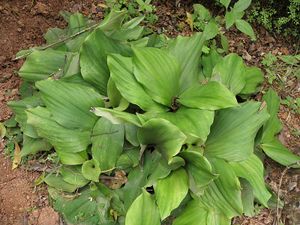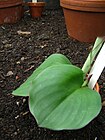Note: This is a project under development. The articles on this wiki are just being initiated and broadly incomplete. You can Help creating new pages.
Difference between revisions of "Kaempferia galanga - Chandramoolika"
(→Uses) |
(→Photo Gallery) |
||
| Line 47: | Line 47: | ||
==Photo Gallery== | ==Photo Gallery== | ||
<gallery class="left" caption="" widths="140px" heights="140px"> | <gallery class="left" caption="" widths="140px" heights="140px"> | ||
| − | |||
| − | |||
| − | + | ||
| + | |||
| + | Cekur (Kaempferia galanga).jpg | ||
| + | |||
| + | |||
| + | Kaemp galan 100614-3323 awr.jpg | ||
| + | |||
| + | |||
| + | Kaemp galan 100614-3328 awr.jpg | ||
| + | |||
| + | |||
| + | Kaempferia galanga 3682.jpg | ||
| + | |||
| + | |||
| + | Kaempferia galanga 3685.jpg | ||
| + | |||
| + | |||
| + | Kaempferia galanga whole palnt.jpg | ||
| + | |||
| + | |||
| + | Kaempferia galanga.jpg | ||
| + | |||
| + | |||
| + | Kampferia galanga.jpg | ||
| + | |||
| + | |||
| + | Kencur Kaempferia galanga.jpg | ||
| + | |||
</gallery> | </gallery> | ||
Revision as of 17:54, 17 April 2018
Chandramoolika, commonly known as kencur, Kaempferia galanga, aromatic ginger, sand ginger, cutcherry, or resurrection lily, is a monocotyledonous plant in the Ginger family, and one of four plants called galangal. It is found primarily in open areas in Indonesia, southern China, Taiwan, Cambodia, and India, but is also widely cultivated throughout Southeast Asia.
Contents
Uses
colds, bronchial complaints, dyspepsia, gastric complaints, headaches, sore throats, coughs, asthma, high blood pressure
Parts Used
Chemical Composition
Lesser galanga rhizome contains about 2.5 to 4% essential oil, whose main components are ethyl cinnamate (25%), ethyl-p‑methoxy cinnamate (30%) and p‑methoxy cinnamic acid; furthermore, 3‑carene-5‑one was found (Phytochemistry, 26, 3350, 1987)[1]
Common names
| Language | Common name |
|---|---|
| Kannada | Kachchura, Kachhoora |
| Hindi | Chandramula, Sidhoul |
| Malayalam | Kachhuram, Katjulam |
| Tamil | Kacholum, Pulankilanku |
| Telugu | |
| Marathi | NA |
| Gujarathi | NA |
| Punjabi | NA |
| Kashmiri | NA |
| Sanskrit | Chandramoolika, corakah |
| English | Aromatic Ginger, Resurrection lily, Lesser galangal, Sand ginger |
Habit
Identification
Leaf
| Kind | Shape | Feature |
|---|---|---|
| Simple | Non-Palm Foliage | Foliar Arrangement Along Stem is Basal and Foliar Venation is Parallel |
Flower
| Type | Size | Color and composition | Stamen | More information |
|---|---|---|---|---|
| Bisexual | Tubular, Cruciform / Cross-shaped | Purple, White | Flower Grouping is Cluster / Inflorescence and Flower Location is Terminal |
Fruit
| Type | Size | Mass | Appearance | Seeds | More information |
|---|---|---|---|---|---|
| 7–10 mm (0.28–0.4 in.) long pome | clearly grooved lengthwise, Lowest hooked hairs aligned towards crown | With hooked hairs | {{{6}}} |
Other features
List of Ayurvedic medicine in which the herb is used
- Vishatinduka Taila as root juice extract
Where to get the saplings
Mode of Propagation
Seeds, Division of the rhizomes.
How to plant/cultivate
A plant of the moister tropics with a distinct dry season, it prefers a humid climate and a minimum temperature that seldom falls below about 18°c[3]
Commonly seen growing in areas
Open forest, forest edges, bamboo forest, at elevations up to 1,000 metres
Photo Gallery
References
External Links
- Pages that are stubs
- Ayurvedic Herbs known to be helpful to treat colds
- Ayurvedic Herbs known to be helpful to treat bronchial complaints
- Ayurvedic Herbs known to be helpful to treat dyspepsia
- Ayurvedic Herbs known to be helpful to treat gastric complaints
- Ayurvedic Herbs known to be helpful to treat headaches
- Ayurvedic Herbs known to be helpful to treat sore throats
- Ayurvedic Herbs known to be helpful to treat coughs
- Ayurvedic Herbs known to be helpful to treat asthma
- Ayurvedic Herbs known to be helpful to treat high blood pressure
- Herbs with Rhizomes used in medicine
- Herbs with Leaves used in medicine
- Herbs with common name in Kannada
- Herbs with common name in Hindi
- Herbs with common name in Malayalam
- Herbs with common name in Tamil
- Herbs with common name in Sanskrit
- Herbs with common name in English
- Habit - perennial herb
- Index of Plants which can be propagated by Seeds
- Index of Plants which can be propagated by Division of the rhizomes
- Herbs that are commonly seen in the region of Open forest
- Herbs that are commonly seen in the region of forest edges
- Herbs that are commonly seen in the region of bamboo forest
- Herbs that are commonly seen in the region of at elevations up to 1,000 metres
- Herbs









